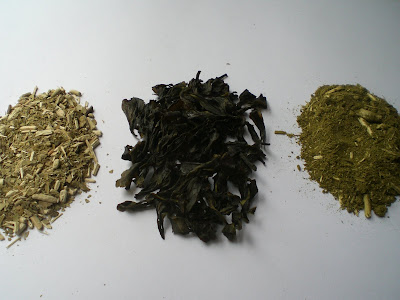
The Complete Leaf Company's Yerba Mate Buds will be truly and literally unique. It will be the first bud-derived yerba product, the first to have whole, unbroken leaves, the first handcrafted yerba product, and the first to come in pyramidal tea sachets. The comparison below (with Brazilian style Chimmarão on the right and Argentine style yerba maté on the left) clearly and powerfully demonstrates exactly how different Complete Leaf's product will be:

Upon steeping, the yerba buds revert back to their vibrant green color. The liquor is clear and greenish green, not opaque and yellowish brown like traditional maté. The smell and taste is similar to green tea but distinctly and uniquely 'yerba-y'. Below is a side by side comparison of Complete Leaf Yerba Mate Buds (left) alongside that of a competitor (right) offering traditional yerba maté:

Below is a photo of The Complete Leaf Company's Yerba Mate Buds in a mesh infuser brewing:

A comparison of Complete Leaf Yerba Mate Buds (right) alongside that of the competition before and after steeping the two:

A stem from the yerba plant alongside a cup with dry budset yerba in it:

That same cup after steeping. The delicate buds have soaked up the hot water, gently unfurled, and reverted to their original shape and color:

Lastly, a sight one will never find in any other yerba in the world, an unbroken delicate interior leaf from a yerba bud after steeping:

What follows in the next posts are descriptions and depictions of the products our competitors offer, our processing methods, traditional processing methods, our raw material, and finally the plant itself.





















